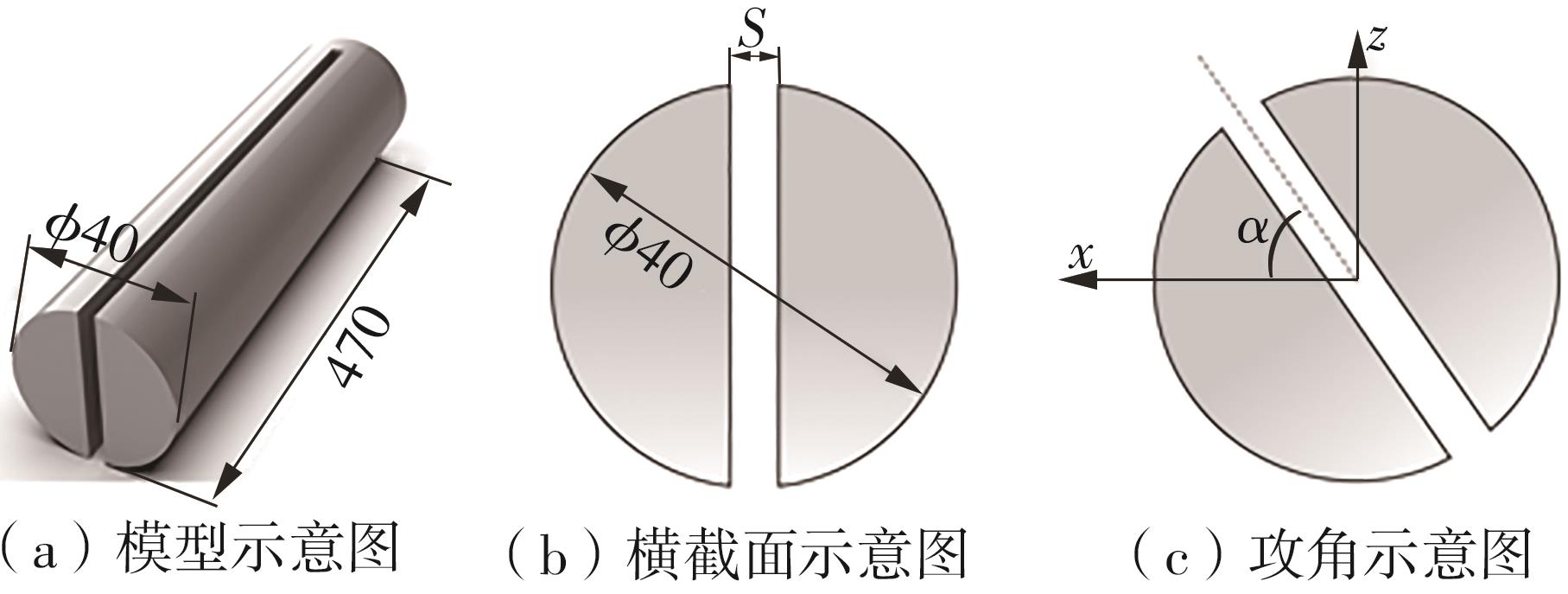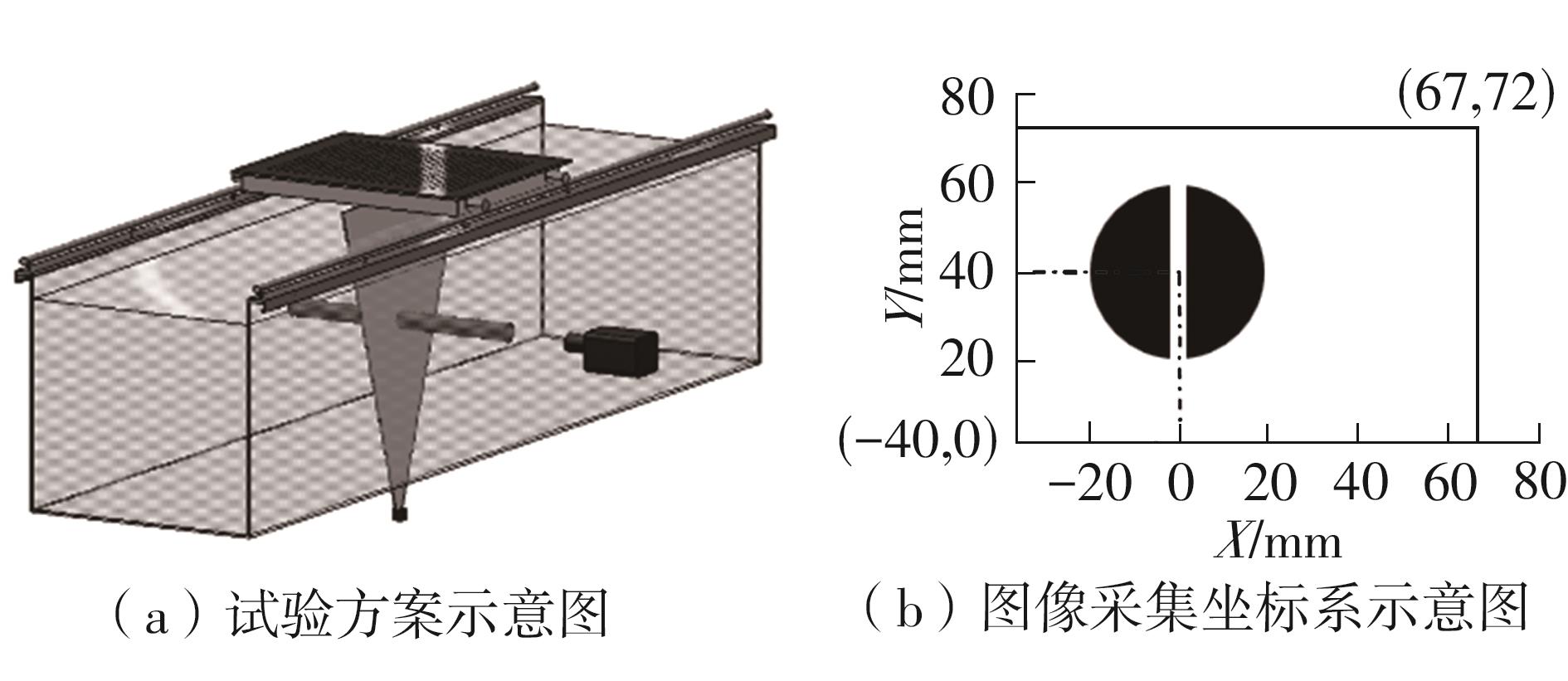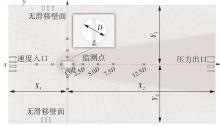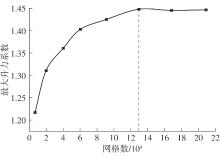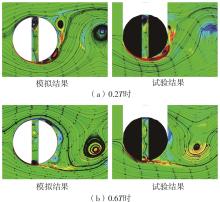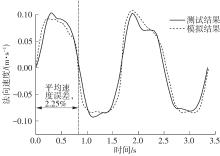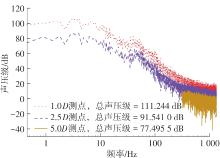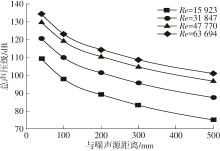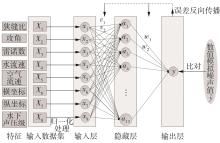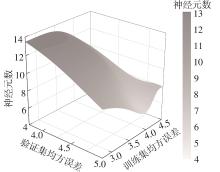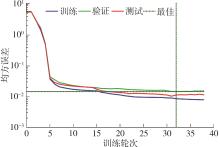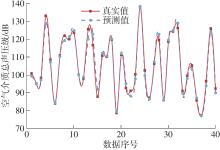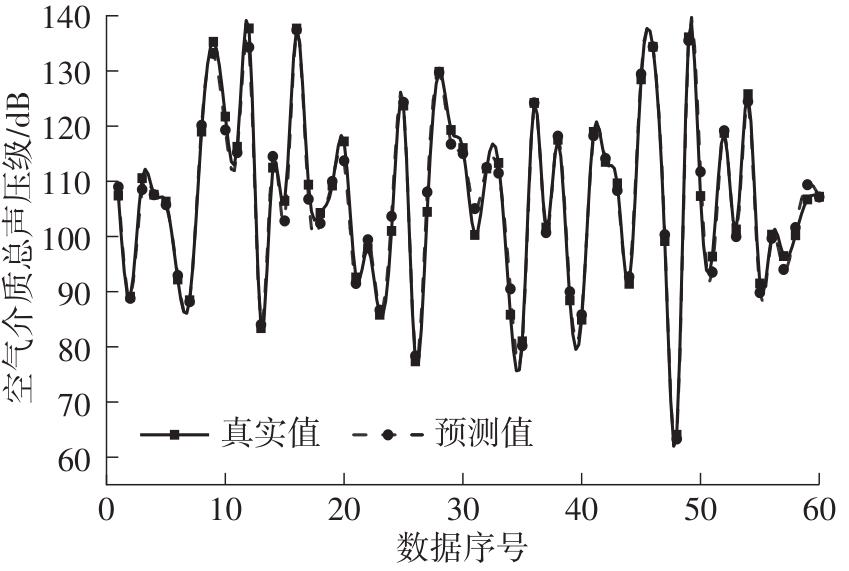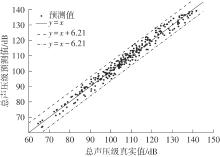Journal of South China University of Technology(Natural Science Edition) ›› 2024, Vol. 52 ›› Issue (12): 119-126.doi: 10.12141/j.issn.1000-565X.240077
Special Issue: 2024年流体动力与机电控制工程
• Fluid Power & Mechatronic Control Engineering • Previous Articles Next Articles
BP Neural Network Prediction Model for Turbulent Noise Intensity in Gas/Water Medium
ZHU Rui1,2( ), LIU Yu2, LIANG Yuying2, SHEN Chuanpeng2
), LIU Yu2, LIANG Yuying2, SHEN Chuanpeng2
- 1.School of Aerospace Engineering,Xiamen University,Xiamen 361102,Fujian,China
2.College of Information Engineering,Xizang Minzu University,Xianyang 712082,Shaanxi,China
-
Received:2024-02-15Online:2024-12-25Published:2024-06-14 -
Supported by:the Key Research and Development Program of Xizang Autonomous Region(XZ202401ZY0102);the Humanities and Social Sciences Program of the Ministry of Education(23XZJAZH001);the Key Natural Science Foundation of Xizang Autonomous Region(XZ202401ZR0055);the Natural Science Foundation of Fujian Province(2022J01058)
CLC Number:
Cite this article
ZHU Rui, LIU Yu, LIANG Yuying, SHEN Chuanpeng. BP Neural Network Prediction Model for Turbulent Noise Intensity in Gas/Water Medium[J]. Journal of South China University of Technology(Natural Science Edition), 2024, 52(12): 119-126.
share this article
Table 1
Part of the input data for the test set"
| 狭缝比 | 攻角/(°) | 雷诺数 | 水流速/(mm·s-1) | 空气流速/(mm·s-1) | 监测点坐标/mm | 水下总声压级/dB |
|---|---|---|---|---|---|---|
| 0.15 | 0 | 63 694 | 1 600 | 23 259.91 | (100,0) | 116.176 |
| 0.10 | 30 | 31 847 | 800 | 11 629.95 | (200,0) | 101.037 |
| 0.20 | 60 | 63 694 | 1 600 | 23 259.91 | (0,200) | 119.498 |
| 0.10 | 90 | 47 770 | 1 200 | 17 444.93 | (100,0) | 119.212 |
| 0.10 | 0 | 63 694 | 1 600 | 23 259.91 | (0,200) | 117.578 |
| 0.10 | 0 | 47 770 | 1 200 | 17 444.93 | (300,0) | 98.980 |
| 0.10 | 30 | 31 847 | 800 | 11 629.95 | (215,0) | 100.019 |
| 0.20 | 60 | 31 847 | 800 | 11 629.95 | (0,20) | 131.598 |
| 0.10 | 60 | 47 770 | 1 200 | 17 444.93 | (0,0) | 145.261 |
| 0.20 | 90 | 63 694 | 1 600 | 23 259.91 | (40,0) | 132.211 |
Table 2
Comparison of total sound pressure level in air medium between numerical simulation results and model prediction results"
| 数值模拟结果/dB | 预测结果/dB | 绝对误差/dB |
|---|---|---|
| 107.41 | 108.98 | -1.57 |
| 89.06 | 88.79 | 0.27 |
| 110.57 | 108.49 | 2.08 |
| 107.56 | 107.57 | -0.01 |
| 106.32 | 105.75 | 0.57 |
| 92.20 | 92.93 | -0.73 |
| 88.44 | 88.17 | 0.27 |
| 119.01 | 120.15 | -1.14 |
| 135.27 | 133.15 | 2.12 |
| 121.71 | 119.29 | 2.42 |
| 1 | DI MARCO A, BURGHIGNOLI L, CENTRACCHIO F,et al .Airframe noise measurements in a large hard-walled closed-section wind tunnel[J].Applied Acoustics,2019,146:96-107. |
| 2 | 赵成,张涛,侯国祥 .基于声扰动方程的矩形柱绕流噪声数值模拟[J].华中科技大学学报(自然科学版),2021,49(10):103-108. |
| ZHAO Cheng, ZHANG Tao, HOU Guoxiang .Numerical study on flow noise of flow around rectangular cylinders based on acoustic perturbation equations[J].Journal of Huazhong University of Science and Technology (Natural Science Edition),2021,49(10):103-108. | |
| 3 | MARTIN R, SORIA M, RODRIGUEZ I,et al .On the flow and passive noise control of an open cavity at Re = 5 000[J].Flow,Turbulence and Combustion,2022,108(1):123-148. |
| 4 | 刘志荣,邹赫,刘锦生,等 .开缝圆柱缝隙倾斜角对脱落涡的影响[J].北京航空航天大学学报,2017,43(1):128-135. |
| LIU Zhirong, ZOU He, LIU Jinsheng,et al .Effect of angle of slit on shedding vortex of slotted circular cylinder[J].Journal of Beijing University of Aeronautics and Astronautics,2017,43(1):128-135. | |
| 5 | 王毅刚,陈垂文,黄晓胜,等 .圆柱绕流近壁面处气动噪声源识别研究[J].声学技术,2019,38(4):422-427. |
| WANG Yigang, CHEN Chuiwen, HUANG Xiaosheng,et al .Study of identification method for aerodynamic noise sources in flow around cylinder[J].Technical Acoustics,2019,38(4):422-427. | |
| 6 | 田斯源,余培汛,白俊强,等 .全尺寸起落架的气动及声学特性分析[J].西北工业大学学报,2022,40(5):953-961. |
| TIAN Siyuan, YU Peixun, BAI Junqiang,et al .Analysis of aerodynamic and aeroacoustics of full scale landing gear[J].Journal of Northwestern Polytechnical University,2022,40(5):953-961. | |
| 7 | GEYER T F .Experimental evaluation of cylinder vortex shedding noise reduction using porous material[J].Experiments in Fluids,2020,61(7):1-21. |
| 8 | 任旺 .飞机起落架结构件气动噪声分析与降噪方法研究[D].南京:南京航空航天大学,2016. |
| 9 | 陈武,周毅 .基于K-FWH声比拟方法的串列双圆柱气动噪声研究[J].北京航空航天大学学报,2021,47(10):2118-2128. |
| CHEN Wu, ZHOU Yi .Investigation on aeroacoustic of tandem double cylinders by K-FWH acoustic analogy method[J].Journal of Beijing University of Aeronautics and Astronautics,2021,47(10):2118-2128. | |
| 10 | JACOB J, BHATTACHARYA S K .Aerodynamic noise from long circular and non-circular cylinders using large eddy simulations[J].International Journal of Aeroacoustics,2022,21(3/4):142-167. |
| 11 | AL-SADAWI L, BIEDERMANN T M, FRITSCHE M .Passive control of vortex shedding noise of circular cylinders by passive air-jet blowing[J].Journal of Aerospace Engineering,2021,34(5):04021060/1-11. |
| 12 | LIU H, ZHANG S, CHEN R,et al .Numerical study on aerodynamic drag and noise of circular cylinders with a porous plate[J].Aerospace Science and Technology,2022,123:107460/1-15. |
| 13 | ZHENG C, ZHOU P, ZHONG S,et al .An experimental investigation of drag and noise reduction from a circular cylinder using longitudinal grooves[J].Physics of Fluids,2021,33(11):115110/1-11. |
| 14 | 朱睿,李尚,陈子煜,等 .二维开缝圆柱环流动力特性[J].上海交通大学学报,2019,53(10):1238-1248. |
| ZHU Rui, LI Shang, CHEN Ziyu,et al .Flow field dynamic characteristics of slit cylinders[J].Journal of Shanghai Jiaotong University,2019,53(10):1238-1248. | |
| 15 | ZHU R, ZHUANG Q, LI S,et al .Overall flow dynamics characteristics of slit-vent cylinders[J].Aerospace Science and Technology,2020,105:106074/1-11. |
| 16 | LYSENKO D A .Free stream turbulence intensity effects on the flow over a circular cylinder at Re = 3 900:bifurcation, attractors and Lyapunov metric[J].Ocean Engineering,2023,287:115787/1-14. |
| 17 | 杨锦文,何意,鲍锋 .开缝圆柱近场尾流的大涡模拟和实验测量[J].空气动力学学报,2014,32(3):308-314. |
| YANG Jinwen, HE Yi, BAO Feng .Large eddy stimulation and experimental measurement of near wake structures of a slotted circular cylinder[J].Acta Aerodynamica Sinica,2014,32(3):308-314. | |
| 18 | MAYS M D, LARDEAU S, LAIZET S .Capturing the drag crisis in the flow around a smooth cylinder using a hybrid RANS-LES model on coarse meshes[J].International Journal of Heat and Fluid Flow,2023,103:109203/1-14. |
| 19 | 李定远,方斌,李一鸣,等 .圆柱绕流特征频率相似性研究[J].舰船电子工程,2022,42(3):197-202. |
| LI Dingyuan, FANG Bin, LI Yiming,et al .Study on the similarity of characteristic frequency of flow around a cylinder[J].Ship Electronic Engineering,2022,42(3):197-202. | |
| 20 | 眭嘉里 .基于数值模拟和BP神经网络的悬垂绝缘子串风偏角预测模型[D].重庆:重庆大学,2020. |
| 21 | 姚景瑜,孟海洋,杨京,等 .基于BP人工神经网络的轴流风扇气动噪声预测[J].南京大学学报(自然科学),2020,56(6):900-908. |
| YAO Jingyu, MENG Haiyang, YANG Jing,et al .Aerodynamic noise prediction of tube-axial fan based on BP artificial neural network[J].Journal of Nanjing University (Natural Science),2020,56(6):900-908. | |
| 22 | 王晓玲,杨姝 .基于多模型融合的BP神经网络组合预测模型的研究[J].电脑知识与技术,2023,19(3):22-25. |
| WANG Xiaoling, YANG Shu .Research on BP neural network combination prediction model based on multi-model fusion[J].Computer Knowledge and Technology,2023,19(3):22-25. | |
| 23 | 刘兆荣 .基于改进激活函数的卷积神经网络算法及应用研究[D].上海:上海海洋大学,2019. |
| 24 | MENG H, XU X, YANG J,et al .Fast prediction of aerodynamic noise induced by the flow around a cylinder based on deep neural network[J].Chinese Physics B,2022,31(6):064305/1-6. |
| 25 | 周梦,吕志刚,邸若海,等 .基于小样本数据的BP神经网络建模[J].科学技术与工程,2022,22(7):2754-2760. |
| ZHOU Meng, Zhigang LÜ, DI Rouhai,et al .BP neural network modeling based on small sample data[J].Science Technology and Engineering,2022,22(7):2754-2760. | |
| 26 | 周中,邓卓湘,陈云,等 .基于GA-BP神经网络的泡沫轻质土强度预测[J].华南理工大学学报(自然科学版),2022,50(11):125-132. |
| ZHOU Zhong, DENG Zhuoxiang, CHEN Yun,et al .Strength prediction of foam light soil based on GA-BP neural network[J].Journal of South China University of Technology (Natural Science Edition),2022,50(11):125-132. | |
| 27 | WANG P, FAN E .Neural network optimization method and its application in information processing[J].Mathe-matical Problems in Engineering,2021,1(10):1-10. |
| 28 | 赵文清,严海,周震东,等 .基于残差BP神经网络的变压器故障诊断[J].电力自动化设备,2020,40(2):143-148. |
| ZHAO Wenqing, YAN Hai, ZHOU Zhendong,et al .Fault diagnosis of transformer based on residual BP neural network[J].Electric Power Automation Equipment,2020,40(2):143-148. |
| [1] | LAN Fengchong, ZHANG Yue, CHEN Jiqing, et al. Correlation Analysis and Prediction of Pedestrian Casualty Risk in Car-Pedestrian Collision Accident [J]. Journal of South China University of Technology(Natural Science Edition), 2022, 50(5): 1-10. |
| [2] | ZHANG Chi, REN Shipeng, WANG Bo, et al. Speed Characteristics and Prediction of Trucks on Long and Steep Downgrade Sections [J]. Journal of South China University of Technology(Natural Science Edition), 2022, 50(3): 38-49. |
| [3] | ZHOU Zhong, DENG Zhuoxiang, CHEN Yun, et al. Strength Prediction of Foam Light Soil Based on GA-BP Neural Network [J]. Journal of South China University of Technology(Natural Science Edition), 2022, 50(11): 125-132. |
| [4] | ZHANG Yirui SU Jian XU Guan. Research on Coupling Effect Experiment and Decoupling Method of 3-D Force Measuring Platform [J]. Journal of South China University of Technology (Natural Science Edition), 2021, 49(5): 135-144. |
| [5] | YANG Chun, LI Penglin, XIONG Shuai, et al. Analysis of Monitoring Data of a Long-Span Steel Roof Based on BIM and BP Neural Network [J]. Journal of South China University of Technology (Natural Science Edition), 2020, 48(9): 10-19. |
| [6] | WANG Yihong, ZHANG Jianxiong, LAN Guanqi, et al. Artificial Neural Network Prediction Model for Compressive Strength of Compacted Earth Blocks [J]. Journal of South China University of Technology (Natural Science Edition), 2020, 48(7): 115-121. |
| [7] | XUE Cuizhen SHEN Aiqin QIAO Hongxia. Freezing-Thawing Damage Mechanism and Evolution Model of Concrete Mixed with CWCPM [J]. Journal of South China University of Technology (Natural Science Edition), 2020, 48(3): 136-144. |
| [8] |
.
Evaluation of Flow Field Simulation of Turbine in Water-Medium Hydrodynamic Coupling Based on PIV Experiment
|
| [9] | NIU Haiqing WU Juzhuo GUO Shaofeng. Application of Singular Value Decomposition to Pattern Recognition of Partial Discharge in Cable [J]. Journal of South China University of Technology (Natural Science Edition), 2018, 46(1): 26-32. |
| [10] | BAO Dan-wen LIU Jian-rong GU Jia-yu . Optimization Model of Airport Bus Line Network Reliability and Algorithm Design [J]. Journal of South China University of Technology (Natural Science Edition), 2017, 45(8): 84-91. |
| [11] | ZENG Xiao-hua LI Guang-han SONG Da-feng LI Sheng ZHU Zhi-cheng. Rollover Warning Algorithm Based on Genetic Algorithm-Optimized BP Neural Network [J]. Journal of South China University of Technology (Natural Science Edition), 2017, 45(2): 30-38. |
| [12] | NIU Hai-qing WU Ju-zhuo XU Jia ZHENG Wen-jian. Identification of Infrared Images of Cable Terminal Based on Radon Transform and Fourier-Mellin Transform [J]. Journal of South China University of Technology (Natural Science Edition), 2016, 44(8): 47-52,59. |
| [13] | Zhang Cheng-wei Xiao Bing. Ignition Delay Prediction of Diesel-Natural Gas Blending [J]. Journal of South China University of Technology (Natural Science Edition), 2014, 42(8): 21-26. |
| [14] | Hu Jun- liang Yu Xiao- lin Zheng Heng- bin Chen Zhou Yan Quan- sheng. Beam Structure Finite Element Model Updating via BP Neural Network Optimized [J]. Journal of South China University of Technology (Natural Science Edition), 2013, 41(8): 67-73. |
| [15] | Wan Xiao- fang Huang Chun- liu Li You- ming Chai Xin- sheng Hu Hui- chao. Preparation of Functional Polysiloxane via Cationic Miniemulsion Polymerization [J]. Journal of South China University of Technology (Natural Science Edition), 2013, 41(7): 75-80,93. |
| Viewed | ||||||
|
Full text |
|
|||||
|
Abstract |
|
|||||

